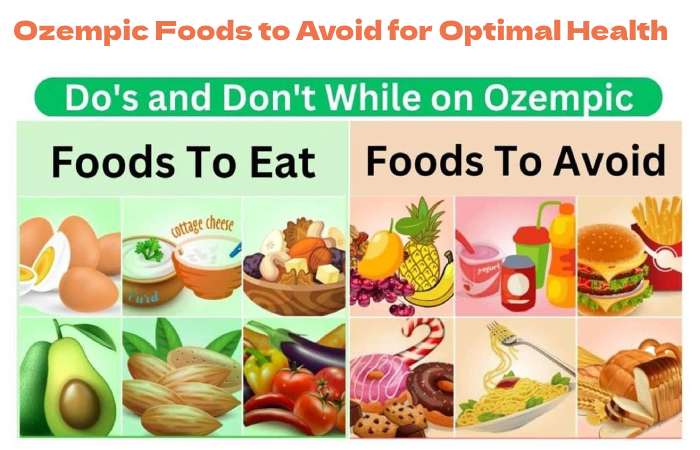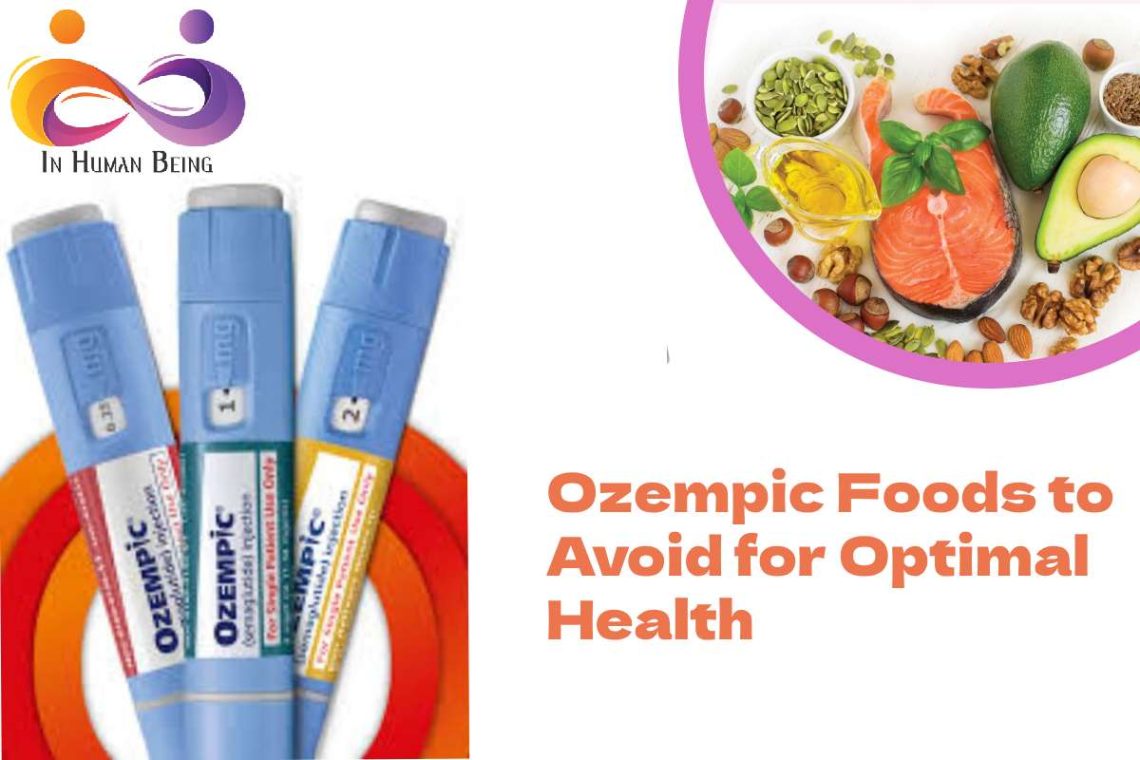Ozempic foods to avoid
Life with Ozempico can be both a blessing and a curse. On the one hand, semaglutide medications like Ozempic are capable weight loss agents for some overweight and obese patients. On the other hand, and as with any medication, the use of Ozempic can cause a series of persistent and unpleasant side effects, which may even lead some to stop.
Fortunately, the quality of life in Ozempic is not entirely out of the patient’s control. It turns out that certain foods are likely to cause or exacerbate adverse side effects for many Ozempic users. Making dietary management a possible avenue to curb some of the drug’s potentially less pleasant effects.
Let’s look under the hood to understand how Ozempic affects the physiology of digestion and to evaluate which ozempic foods to avoid.
Action mechanisms
Semaglutide medications like Ozempic promote weight loss by mimicking a naturally produced hormone called GLP-1. It causes an overall increase in satiety and a decrease in hunger at the brain level, reducing patients’ desire to crave foods they would otherwise crave.
The medication also reduces the rate at which ingested food empties from the stomach, physiologically extending the time during which the patient experiences a feeling of “fullness” after a meal. It may take several hours, or sometimes days, for the stomach to empty its contents with Ozempic, although the magnitude of this effect varies depending on the dosage and different types of food.
Impact on Digestion and Side Effects
While Ozempic’s impacts on digestion can be productive for weight loss and blood sugar control, disruptions to normal digestive function can manifest in uncomfortable gastrointestinal disorders. Although patients generally seek to avoid such effects, scientists at the drug’s manufacturer, Novo Nordisk, have noted that common side effects, such as nausea, may be due to the impact of Ozempic. Manifest on a subjective level. In other words, food is usually the last thing you think about when feeling sick. And since reducing cravings is a big part of what Ozempic does, this may be more of a feature than a bug.
Managing Side Effects
Although this perspective may help patients reframe their view of side effects. It should also be considered that many patients who discontinue their Ozempic treatment do so because they can no longer endure the resulting significant discomfort. In such cases, discontinuing the medication prevents it from achieving its goals. This means better solutions are required for managing side effects than simply reframing how patients see them. It is where it can be helpful to understand better the relationships between certain foods and the likelihood of side effects.
Please note that in any case, monitoring the side effects of any medication should be approached only under the supervision of a doctor.
Side effects
As noted above, the most common side effects of Ozempic involve the gastrointestinal tract. The most frequently experienced adverse effect is nausea, which is reported by up to 20% of users. Runners-up include vomiting, diarrhea, and stomach cramps, which reportedly occur in the range of 5 – 10% of patients taking it.
- Patients also often report being overfull, probably due to Ozempic’s tendency to keep food in the stomach for a prolonged period.
- Gas and belching are also standard, as gas formation from the digestive process takes longer.
- Constipation is another unfortunate possibility with the treatment and, once again, this is due to Ozempic’s tendency to
- Completely slow down the digestive process. The reduced speed at which food is processed in the intestines can cause
- We digested food to build up in the colon and make bowel movements difficult.
Hacking the system
Understanding the link between Ozempic’s mechanisms of action and the side effects it sometimes produces should not necessarily be a reason for pessimism. It turns out that Ozempic does not affect the digestion of different foods equally, and understanding how and why certain foods are more easily tolerated can help users develop a dietary strategy to minimize discomfort.
The longer a given food takes to digest, the greater the chance it will cause problems for Ozempic patients. It means that foods processed more quickly in the digestive tract may cause less nausea, vomiting, abdominal pain, and other common adverse effects.
If you are experiencing significant side effects that make it difficult for you to consider continuing taking the medication.
Avoiding certain problem foods and opting for more tolerable foods may be a helpful place to start your problem-solving journey. The severity and frequency of side effects may also increase proportionally with the dose of Ozempic. It may also be advisable to consult your doctor about adjusting the dose.
Ozempic foods to avoid

First, the good news: There are generally no hard limits on foods a patient can safely consume with Ozempic. Patients can usually eat any food they can tolerate without other individual health considerations, allowing flexibility around dietary choices. These guidelines can, therefore, serve as a helpful starting point for addressing potential nutritional causes of discomfort but should not be viewed as an absolute list of dos and don’ts.
Now, the bad news. Many of our favorite comfort foods (particularly those high in fat or other fats, sugars, or alcohol) tend to be the worst culprits in causing discomfort. Ozempic Foods to Avoid include these high-fat, sugary, or alcoholic items, as they tend to languish in the stomach for a long time, creating an environment conducive to many of the unpleasant effects described above.
Fat
Avoiding fatty and fat-laden foods is no easy task in modern America. Fat is flavor, as the saying goes, so food marketers and manufacturers inject fat into our favorite fast food and snack options. Chances are good that most items at your favorite fast food restaurant are fried in fatty oil, drizzled with fatty dressing, filled with fatty ground beef, or some combination of the above. Avoiding or minimizing fast food can go a long way in eliminating unnecessary and harmful fats contributing to your Ozempic problems.
Even “healthy” or homemade foods can contain considerable amounts of fat. Dairy products like butter, cheese, yogurt, and skim milk contain significant fat levels. Cooking oils are also responsible for much of our fat intake, whether it’s vegetable oil for frying foods, olive oil for salad dressing, or oils marketed as healthy alternatives like Coconut or avocado oil. So what should an Ozempic patient concerned about her health do?
It is essential to clarify that fat should not be seen as the enemy. Dietary fat supports various bodily functions, including hormonal regulation and cushioning vital organs. However, different sources of fat have varying health values. Many people consume more fat daily than is necessary.
If you think fats might be reacting poorly in your gut, evaluate the types and amounts of fats you’re consuming. Assess whether you can adjust your intake to minimize side effects. This approach could help you achieve better health benefits from your diet.
Sugar and carbohydrates
Ozempic’s manufacturer, Novo Nordisk, has advised that Ozempic patients should avoid sugary foods as the resulting blood sugar spikes limit the effectiveness of Ozempic in regulating insulin levels and may increase the likelihood of experiencing side effects. However, this is not the same as advising patients to avoid carbohydrates altogether. Instead, patients should understand how different carbohydrate sources vary to prioritize the healthiest and least problematic options.
Different sources of carbohydrates vary in the speed at which they are processed in the body. Consequently, carbohydrate-rich foods are assigned glycemic index (“GI”) numbers from 0 to 100, which indicates how quickly and drastically that food will raise a person’s blood sugar levels. Pure glucose is assigned the highest possible GI score of 100, while non-carbohydrate foods like fish are assigned a 0. Understanding carbohydrate sources based on their GI scores can be helpful for diabetes patients. Ozempic Foods to Avoid include foods with higher GI numbers, which are generally more likely to increase blood sugar and create potential problems.
Complex carbohydrates consist of many smaller molecules linked together in a chain. As a result, it takes longer for digestion to break down these molecules into glucose. Fibers are the most drastic example of a complex carbohydrate, as their complexity prevents the body from breaking them down completely. Beans, legumes, whole grains, and certain vegetables also fall lower on the GI scale.
In contrast, simple carbohydrates like refined sugars and starches have a high GI score. They are quickly digested into glucose, leading to a rapid rise in blood sugar levels. Foods such as sugary syrups, candy, white bread, white rice, and sugary soft drinks provide a direct glucose boost, which can destabilize blood sugar levels.
Cruciferous and fibrous vegetables.
A quick warning: Not all vegetables are created equal to carbohydrates. And, while low-Gl foods tend to be a preferable option for Ozempic patients, certain vegetables are so high in fiber that they become problematic.
A slower burn is ideal for carbohydrates, but slow digestion can also cause issues with Ozempic. Vegetables high in fibrous fiber, often with a “stringy” texture, can linger in the intestine, leading to gas and prolonged feelings of fullness.
Even among the general population, it is no secret that these foods often cause flatulence and stomach gas. These effects are only magnified in patients taking Ozempic. Ozempic Foods to Avoid in this category would include pineapple, celery, broccoli, cabbage, Brussels sprouts, and asparagus.
Alcohol
We may not think of alcohol as having any nutritional value, but alcoholic beverages tend to be packed with sugar and calories. While alcohol itself contains no carbohydrates, it is also very caloric, containing approximately 80 calories for a
Shot of a 40% clear liquor like vodka. So, just from a weight loss and blood sugar control perspective, there’s already a good reason to moderate alcohol consumption.
However, you may not have known that alcohol also tends to irritate the stomach lining. While this is generally not a
Problem: alcohol consumed by Ozempic patients is likely to remain in the stomach longer, giving it more time to irritate. If you notice that your side effects tend to worsen after a night of partying, consider alcoholic beverages as the prime suspect.
Coffee
The acidic nature of coffee can cause stomach problems for some people. Coffee itself has little nutritional content and usually doesn’t affect stomach emptying. However, the cream, sugar, and other toppings many add can slow digestion. This allows the acidic coffee to cause more stomach irritation.
Additionally, the high fat and sugar in common coffee additives can lead to side effects. Ozempic patients may want to cut down on coffee or use lighter additives like skim milk or natural sweeteners.
Conclusion
Ozempic is a powerful medication that can transform body weight and diabetes control while affecting digestive function. To fully enjoy life with Ozempic, some adjustments may be needed to manage its side effects, like nausea or gastrointestinal issues. Using the tips in this article, Ozempic Foods to Avoid problematic foods is a good starting point. Patients should consider exploring these strategies with their doctors for optimal results.

